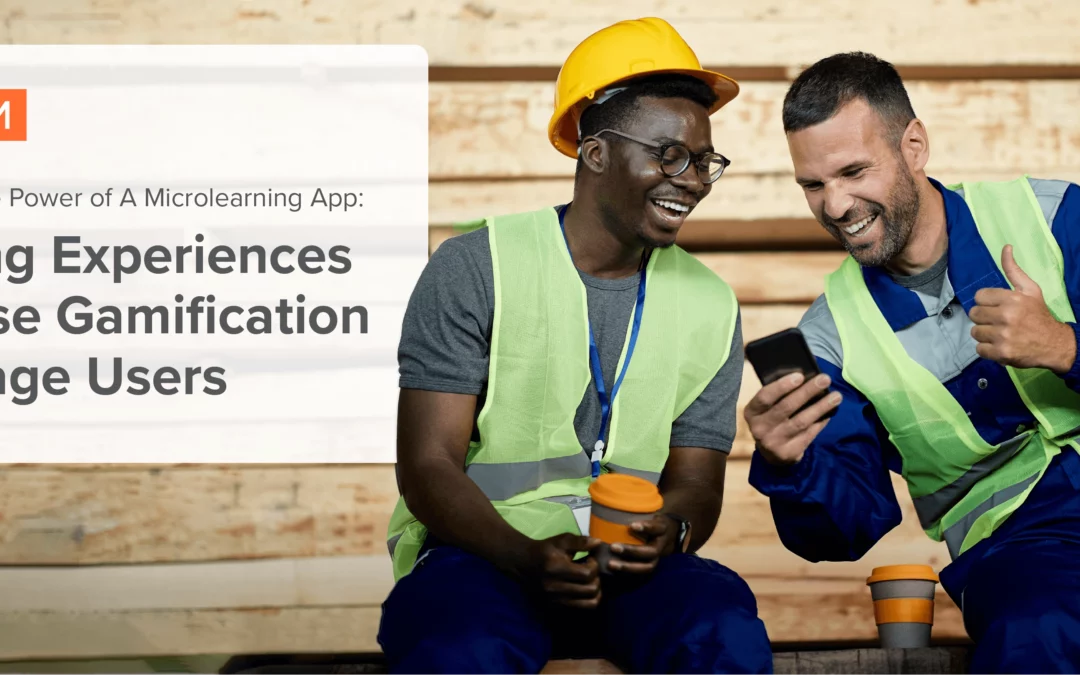Welcome to part two of our comprehensive five-part series on the benefits of utilizing a microlearning app to deliver microlearning experiences, and the five key microlearning areas actively shaping how we acquire knowledge and skills. In this segment, we’ll get an inside look at digital learning trends and explore the popular approach of gamification.
A Catalyst for Engagement
In today’s ever-evolving digital landscape, gamification has emerged as an innovative way to engage and motivate learners. Drawing inspiration from the world of games, gamification infuses elements of gameplay – such as challenges, rewards and competition – into educational experiences. This strategy has gained widespread recognition for its ability to enhance teaching outcomes and create an immersive and interactive learning environment.
In the most effective microlearning apps, gamification incentivizes engagement. It infuses the learning experience with game-like elements which promote active participation.
Key Aspects of Gamification in Microlearning Apps:
Bite-sized content: A microlearning app delivers information in small, easily digestible chunks. These focused learning modules are designed to deliver specific, actionable information that can be absorbed and applied quickly. Gamified elements create an interactive connection between the learner and the content. This connection holds the employee’s attention and makes learning exciting.
Easy access: Mobile devices make it incredibly easy to create and deliver microlearning content. And they are a highly effective tool to engage an on-the-go workforce. A recent survey found that 93% of U.S. employees who own a smartphone and spend at least one-third of their time away from a desk use their phone for work daily. A microlearning app that employs gamification stimulates the hippocampal memory, the area of the brain that converts and stores new information into long-term memory.
Dopamine: This neurotransmitter linked with motivation and recall controls reward-motivated behavior. Dopamine is released with the anticipation of an expected reward, so it’s not surprising that we get a hit of it every time we pick up our smartphone. Gamification stimulates the hippocampal memory (where dopamine is released) which not only makes learners feel good, but encourages long-term knowledge retention.
Social Learning: Social learning theory suggests that humans learn new behaviors by observing and imitating others. This is equally true whether we imitate what another is doing in a video or in person. A video-based microlearning app that utilizes gamification provides an excellent means of social learning through:
-
- Points and badges that reward: Gamification in a microlearning app introduces a system of points and badges that reward and recognize learners’ achievements. Users feel a sense of progress and accomplishment by earning points for acquiring knowledge.
- Progress tracking: A microlearning app enables learners to quickly view their progress and past performance at a glance. This can be done by sharing stats, scoring, leaderboards and learning and engagement streaks.
- Real-world competition: Gamification bridges the digital with the physical world. Gamified elements in a video-based microlearning app provide positive social stimuli that reinforce whatever behavior preceded it. For example, gamified elements such as a leaderboard publicly present achievements and promote a sense of competition outside of the app that fosters an ongoing desire for improvement and knowledge retention. In other words, friendly competition through a digital app can influence engagement, adoption and behavior.
- Feedback and guidance: In a microlearning app, gamification provides instant direction for learners. Through immediate feedback, learners receive reinforcement for correct answers and additional guidance for incorrect ones. This “fast feedback” immediately identifies learner strengths and weaknesses, encouraging a continuous cycle of learning. In fact, 84% of employees who receive fast feedback say they are engaged in their work leading to a happier, more productive work environment.
A word of warning – video-based microlearning and gamification are only as effective as their content and structure. Be sure to eliminate any distracting gamified elements such as mid-stream puzzles, matching exercises, ordering lists and similar challenges. These puzzles will actually hinder true learning. Why? Because the learner is more likely to remember how to solve the challenge – the steps of the puzzle, the matching of colors, the order of items, and not the actual content it was testing.
Microlearning Apps & Gamification
Gamification harnesses the above principles of game design and applies them to the microlearning experience. This challenges, rewards and fosters an engaging – and competitive – environment that captures attention and motivates active participation.
Tyfoom is propelling organizations toward a future of learning that is more accessible, engaging and personalized than ever before by merging the power of gamification with microlearning. Companies can bridge the skills gap, connect and empower their employees, and enjoy the benefits of higher retention rates and the standardization of best practices. In today’s competitive business landscape, video-based microlearning is not just a trend; it’s a strategic advantage that fosters engaged, productive and empowered teams and engages users.
Tyfoom is continuously innovating and adapting to the changing needs of organizations and learners to help transform true knowledge transfer and promote highly-engaged corporate learning cultures. To learn more about how Tyfoom is revolutionizing employee training, communication and engagement, schedule a meeting to speak with a Tyfoom training consultant.
Microlearning Trends: Part Three
We invite you to continue this journey as we learn more about personalization in our next segment. In this post we highlight the extensive customizability of microlearning, and how tailoring the content, pace, and delivery of modules ensures maximum relevance and effectiveness for each learner.

